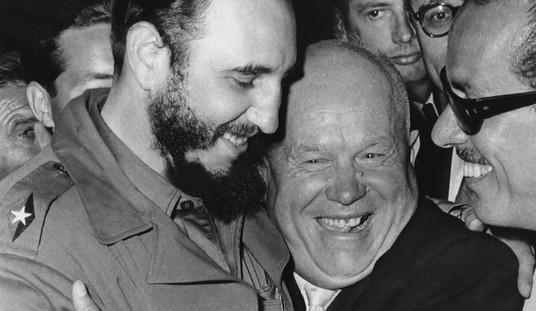For a year, Republicans have worried about having to face a billion-dollar Re-Elect Obama machine in the fall. Most have just assumed that whoever wins the GOP nomination will have to contend with being outfunded and outgunned, even apart from the usual Democratic advantages of the news media and entertainment industry. National Journal punctures this expectation by looking at the pace of fundraising for Barack Obama’s campaign and the outside groups expected to boost him into orbit:
This year, it’s the Republicans’ adept and aggressive use of super PACs to even the financial playing field, blunting the often-massive money advantages that an incumbent president has at his disposal. With the emergence of American Crossroads, Crossroads GPS and Restore Our Future, a well-stocked Romney super PAC, the Obama fundraising juggernaut no longer looks so imposing. If Romney is the Republican nominee, he won’t be overwhelmed with a wave of negative advertising, and will have the resources to fight back.
Take a look at the end-of-year numbers. The Obama campaign ended the year with $81.8 million cash-on hand – a very strong total. But the outside Democratic groups, especially the party’s newly-created super PACs, haven’t given him much assistance in the way of reinforcements. The Democratic National Committee has $12.6 million cash-on-hand to assist. But Priorities USA banked a meager $1.5 million, receiving money from just 42 individual donors in the last six months. The party’s Congressional super PACs – Majority PAC and House Majority PAC — also didn’t bank much, $1.3 million and $1.17 million, respectively.
Meanwhile, the Romney campaign ended the year with $19.9 million in the bank, far less than the president’s cash haul. But when you add in the outside groups, he’s about at even strength. Romney’s super PAC, Restore Our Future, banked $23.6 million at the end of the year, thanks to funding from venture capitalists aligned with Romney. American Crossroads, which is poised to play an outsized role in the presidential race, ended the year with $15.6 million cash-on-hand. And the RNC ended the year with more cash-on-hand than the DNC, banking $20 million. All told, that adds up to $79.1 million – and it doesn’t include the cash-on-hand from Crossroads GPS, which doesn’t file with the Federal Election Commission. But based on Crossroads’ announced fundraising totals, it’s logical to assume that they have around $15 million on-hand.
That brings the combined Obama + Democratic outside group totals to $98.3 million cash-on-hand, with the GOP groups tallying $94.1 million. Take out the Democratic groups strictly devoted to Congressional activities, and it’s a virtual financial tie. With labor and environmental groups poised to help Obama’s re-election, Democrats still could hold a narrow edge. But it’s hardly the cash advantage that would allow Team Obama to run negative advertising uncontested against Romney, without an aggressive response.
The fundraising pace for Obama’s campaign itself, and not the total with the DNC, has actually lagged slightly behind that of George W. Bush in 2004. The amounts have also fallen a bit each time in the last two quarters. I’ve noted that at each disclosure point in 2011 and projected the eventual total to somewhere around $250 million — a substantial number and certainly good enough for a three-month general election campaign, but the billion-dollar behemoth is as likely as a the Loch Ness monster giving an interview over the summer.
That’s not the only advantage disappearing, either. Gallup released Obama’s job-approval ratings in 2011 by state yesterday, and he only tops 50% in ten plus the District of Columbia:
In 10 states plus the District of Columbia, a majority of residents approved of the job Barack Obama was doing as president last year, according to aggregated data from 2011. His greatest support came from District of Columbia, Maryland, and Hawaii residents, while Utah and Idaho residents gave him his lowest levels of support — below 30%. …
With the average state showing a 3.2-point drop in approval between 2010 and 2011, the number of states showing majority approval of Obama did not change much between the two years, moving from 12 states and the District of Columbia in 2010 to 10 states plus D.C. in 2011. Washington state and Rhode Island were the two states that dropped below 50% approval last year.
However, Obama was on pace to show an increase in majority approval states — to 16 plus the District of Columbia — midway through 2011. But his lower approval ratings in the third and fourth quarters of the year resulted in a net decline in the number of states above 50% approval by the time the year was complete.
The news was actually worse when comparing 2011 to 2010, which wasn’t exactly a banner year for Obama and Democrats anyway. Obama’s job approval rose between 2010 and 2011 in only three states — Wyoming (where it could barely have gone lower anyway), Connecticut, and Maine. In key states for the 2012 election in either the Presidential or Senate races, Obama dropped significantly:
- Nebraska: -6.9%
- New Mexico: -6.9%
- Nevada: -5.7%
- Montana: -5.3%
- Ohio: -5.3%
- Colorado: -4.8%
- North Carolina: -3.2%
- Florida: -2.2%
The two trends are probably not unrelated, either.









Join the conversation as a VIP Member